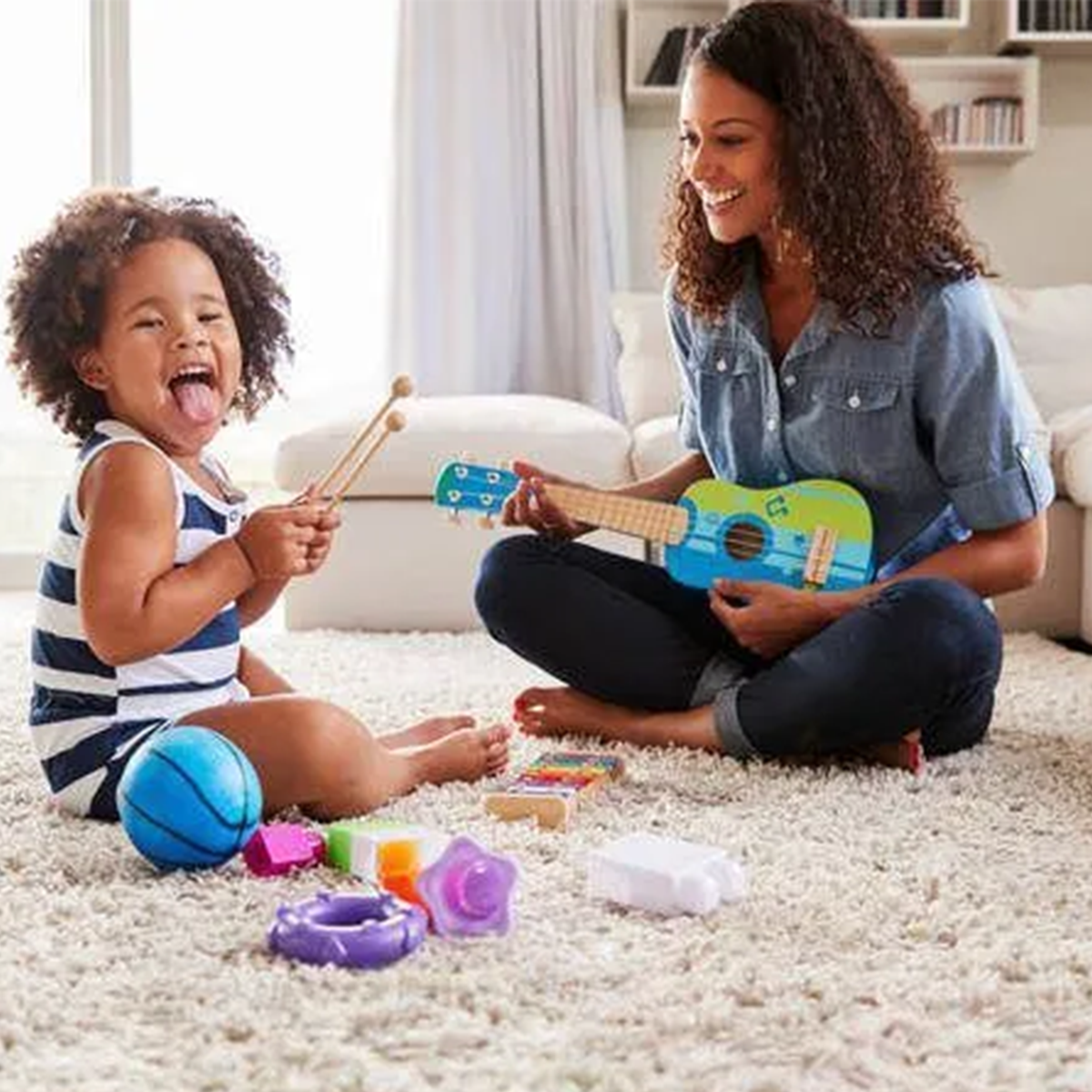Piaget believes that around the age of two, the child first becomes aware of the changes their actions produce on objects. For example, they realize that striking a pen on paper creates lines, or that moving their bed will produce a sound.
At this age, the child is very active and enjoys running, climbing, and throwing objects. Therefore, provide opportunities and environments for free and active play both at home and outdoors. Encourage the child to engage in free play with small balls. The child may throw the ball toward adults or other objects. Use medium-sized, soft balls to avoid injury or causing fear in the child.
Encourage the development of the child’s ability to build objects using hands and fingers. Guide them to play with hollow pieces, cups, and other stackable tools. Promote free play with large plastic nuts and bolts, ensuring they are not small enough to be swallowed. Encourage the child to place items, blocks, and other objects inside cups or larger containers. Provide containers with wide openings and lids so the child can practice opening and closing them.
At this age, the child becomes curious about themselves. Encourage the child to engage in free play with safe, non-hazardous mirrors. Sit or stand with the child in front of the mirror and talk about their perceptions of what they see. Encourage them to make physical and expressive movements—using their hands and body—to interact with their reflection.
You can start helping the child understand some basic concepts such as cause, effect, combination, and size. Talk about the texture and composition of objects the child can touch and feel. For example, say: “The rattle is hard and firm,” or “The blanket is soft.”
Talk to the child about the cause-and-effect relationship. For example, say: “If you turn the cup upside down, the juice will spill,” or “If you stand in the rain, you will get wet.”
At this age, the child is able to recognize objects, animals, and people from a picture. Provide plastic animal figures for free play. Talk with the child about each animal’s name, color, sound, and other characteristics.
Provide simple picture books. Ask the child to point to the objects and animals as you name them. Talk about the pictures. Discuss the size of objects. For example, say: “This is a big ball” or “This piece is smaller than that one.”
From around 12 months onward, the child bangs whatever is within reach. This behavior peaks around 15 months and almost disappears by 18 months.
A child between 13 to 18 months enjoys playing “peekaboo” very much and can play hide and seek. They push and pull wheeled toys.
A child between 9 to 13 months pays more attention to toys than to playmates, because the child values toys greatly during this period. At this age, children may show a tendency to fight over toys.
At 14 months, the child plays with a car and makes a sound similar to it.
At 15 months, the child may insist on standing and briefly focus on the blocks. Usually, the child does not attempt to build anything but just knocks down the blocks or brings them to his/her parents.
At 16 months, the child plays with dolls, sings lullabies to them, and puts them to sleep.
Around 17 months, children are very fond of wheeled toys that have tassels and bells on their wheels, which make sounds when moving. At this age, the child throws toys and explores the effects, and likes to put objects one by one into a container and then take them out.
At around 17 and a half months, the child plays imaginatively with a car or pretends to be a car and moves backward.
At 18 months, the child can put a nail into a hole, flips two to three pages at once (cannot turn pages one by one), holds a pencil and draws lines well, and stacks 2 to 3 blocks on top of each other.
Between 12 and 18 months, the child places objects that have the same function and characteristics next to each other. Around 18 months, the child can draw vertical and horizontal lines with a pencil.
Children at 18 months can connect two toy blocks together, and by 2 years old, they can connect six blocks together
At 18 months, the child can walk and take their doll along, with the help of their mother can build a train, car, airplane, etc., with Lego and make their sounds. If another child takes their favorite toy, they take it back by force and shouting, and kick the ball away with their foot.
At 18 and a half months, the child really enjoys the noise of coins and puts them inside a purse and then takes them out again.
Between 12 to 18 months, pushing a wheeled toy gives the toddler a sense of security. When sitting, they like to stack bowls and cups with their increasingly skilled hands. At this age, they enjoy music boxes and playing with sand. Provide them with buckets, watering cans, and small tubs of water or sand to play with.
Between 18 to 24 months, the child touches everything, goes everywhere, makes noise, messes up everything, and moves things around. A wooden horse or train to pull along, building blocks, and a truck or compressor toy that can be filled and emptied are useful for the child.
At 19 months, the child participates in all group games and sometimes invites a favorite child to play. The child still puts new objects and things they have not seen before into their mouth but never swallows them. They can stack four Lego pieces to build a tower or an apartment. Using an empty plate, bowl, and spoon, the child pretends to eat and says, “The food is delicious,” and offers food to their parents as well.
For children aged 19 to 25 months, toys and playmates become more important. Social interaction matures, and the child shows more tolerance to adapt with playmates, changing their behavior accordingly.
At 20 months, the child plays with two small cars, crashes them together, and laughs. At this age, the child prefers to play more with older children and shows more affection towards younger children.
At 21 months, the child kicks the ball irregularly and lines up blocks to make a train. He/she hugs their doll, walks it around, pats its back to make it sleep, or lays it on the ground, hits it, and says: “Dead!”
A 1 to 2-year-old child plays with LEGO blocks by using specific shapes, stacking them, and connecting them together.
Pretend play usually begins between 1.5 to 2 years of age and reaches its peak during preschool years.
At two years old, the child regularly kicks a ball and can build a tower with six blocks. At this age, the child feeds a doll, takes it for a walk, plays with water and sand, knows their own toys very well, and is unwilling to share their toys with other children.
At two years old, the ability to draw circular or angular lines begins to appear. Around this age, a swing can become for the child a spaceship traveling to a distant planet or a wild bird flying in the sky.
At two years old, the child is interested in plastic bowls, wooden spoons, keys, and empty cans. Therefore, it is better to provide old containers and some inexpensive plastic utensils for children.
In the second year of life, play holds a special and deep meaning for the child. For example, a little girl might wrap her toy in a blanket and put a piece of bread in her teddy bear’s mouth, engaging in activities like these. Therefore, the toys given to the child should have more meaning. Balls, building blocks, dolls, various animals, utensils, and similar items can be suitable toys for children. At two years old, the child flips pages one by one, strings beads, rolls paper without imitation, and cuts paper with scissors using one hand.
A two-year-old child can continue playing one game for about seven minutes in a row. After that, they get tired and move on to another game.
At two years old, the child runs well, falls down less often, climbs stairs, is very active, lively, and energetic. They can build a tower with six blocks.
Between 20 to 24 months, the preferred play for girls includes playing with dolls, soft and delicate toys, seeking help, dancing, and dressing up. For boys, the preferred play includes playing with blocks, handling tools and equipment, and playing with toy cars and vehicles.
A two-year-old child can ride a small tricycle, but since they cannot yet pedal, they push the tricycle forward with their feet.
By the end of the second year, sometimes children include others in their play and engage in two-way (interactive) play. At this stage, even if there are three children, two of them play together while one plays alone.
Some suitable toys for children aged 1 to 2 years include: medium-sized soft balls, plastic screws and nuts, large building blocks, hollow pieces, mirrors, simple picture books, wheeled toys, nails, hammers, soil, sand, water, buckets, shovels, watering cans, basins, various animal figures, dolls, scissors and paper, tricycles, pencils, and paper.
media: پرتال جامع علوم انسانی






